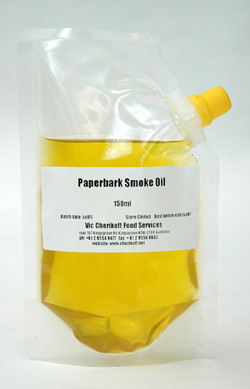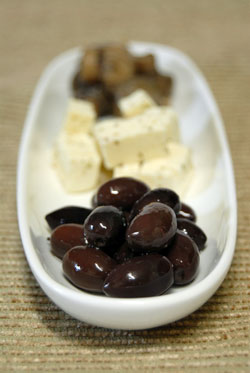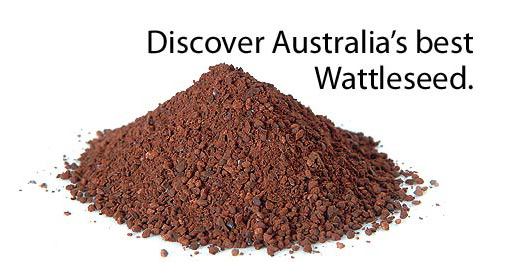So What the Bloody Hell is Wattleseed?
For over 6000 years, Australian Aborigines in different clans around the country, parched and milled wattle seeds from around 100 of the 900 plus species of Acacia, then used the coarse flour in baked seed cakes. This all changed in 1984, when the accidental discovery by
Vic Cherikoff created the modern day product known as Cherikoff Wattleseed).
This is more of a flavouring (natural of course) made from nothing but specially selected species of wattle seeds, carefully and artfully roasted using a particular temperature regime to bring out a wonderful and specific profile of Maillard flavour products which we so love in chocolate, baked foods and roasted nuts. The Wattleseed is then ground, again employing specially developed technologies so that the resultant particle size is small enough for maximal flavour extraction in a wide variety of uses but not so fine as to impart a dusty character on the tongue. This research and refinement of the product makes Cherikoff Wattleseed indisputably the best on the market. The proof of this claim is that it is now highly regarded globally by creative chefs and innovative manufacturers for the unique coffee, chocolate and hazelnut flavours that it imparts.
These days, Cherikoff Wattleseed is used extensively around the world from mainstream bakers in Europe to fine dining restaurants, specialty chocolatiers and ice cream manufacturers in New York. Celebrity chefs such as Emeril Lagasse made Cherikoff Wattleseed ice cream on his TV show; Peter Gordon (of NZ and UK fame) uses it in his London eatery (in his signature dish); Graham Kerr has used it for his new, low fat, super healthy cuisine on his most recent TV series; and now Luis Diaz at Wolfgang Puck’s Chinois is about to grasp the flavour impact of it is his cooking. Wattleseed Anzacs biscuits on QANTAS flights are now an iconic inclusion and recently Wattleseed was served to Queen Elizabeth II on her recent visit to Australia. And this is just a smattering.
Numerous Aboriginal communities along with some dedicated, contracted non-Aboriginal harvesters now gather the small wattle seeds across more than a million square miles (kilometres if you must) of country. While plantations are about to begin yielding reasonable quantities of wattle seed, the mechanical harvesting methods trialled so far have not yet provided the most ideal system. Everything from vacuum to combine harvesters have been developed, modified and tested but there is still more work in this area to do. Without doubt, as the market for tonnage grows, the imperative to engineer the best yielding harvesters will grow too and this time is getting nearer as new markets for Cherikoff Wattleseed are found and developed.
While nutrition has little to do with most people’s food choices, Wattleseed is a great inclusion in anyone’s diet. It has an unusually low glycaemic index which means that the carbohydrates in it are slowly absorbed and therefore better for you than sugary, quick release alternatives. Wattleseed can also be incorporated into foods to lower the overall GI and either just improve its nutritional value or to actually make some food acceptable for people with non-insulin dependent diabetes.
But for anyone who simply enjoys great food, Cherikoff Wattleseed is well suited for a wide range of dishes, sauces and condiments. Either in dry form or as the liquid extract, Wattleseed can be used in sauces, rubs and marinades, crumbs, coatings and batters. It’s superb in baked foods such as breads, biscuits, muffins and cakes and also in desserts including custard and custard desserts, bread and butter puddings, crème patisserie and of course, the now famous, rolled Wattleseed pavlova. Wattleseed is terrific in pancakes, waffles, crumpets, scones, bagels or pretzels; also in dairy desserts with Wattleseed ice cream being a certain world flavour soon and even Wattleseed drinking yoghurt, flavoured milk and soy milk are worth trying. And last but not least is the use of Wattleseed in beverages. Try it as an espresso or simply boiled briefly and strained (unlike coffee, Wattleseed can handle boiling temperatures). I find it better with milk as it brings out some sweetness and rounds out the flavour. It’s good blended with coffee if you need the caffeine hit and there are companies already marketing Wattleseed chai. However, one of my favourite uses is to add 1% Cherikoff Wattleseed extract to a mild flavoured beer (not too hopped).
Manufacturers are already using Cherikoff Wattleseed in many of the above applications in commercial and retail products and much of our work is in assisting companies bring out the best in their new product development using this great flavour. And to give you a little insight into the future, we are now looking at new Wattleseed extracts made with liquid carbon dioxide (sub-critical CO2) extraction techniques. These give us concentrated flavours which can be used in low moisture applications (confectionery, chocolate, cheeses, honey etc).
Cherikoff Wattleseed is currently available to chefs and manufacturers in two forms, either as Wattleseed (a milled product like coffee grounds as described previously) or Wattleseed extract which is more convenient and easier to use.
Wattleseed is available online for delivery right around the world. To order, simply visit the
Dining Downunder online store


